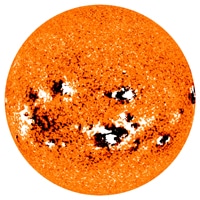An international panel of experts led by the National Oceanic and Atmospheric Administration’s Space Weather Prediction Center (SWPC), which is funded by NASA, is predicting that a new active period of solar storms will be the weakest since 1928. The panel predicts that the upcoming Solar Cycle 24 will peak in May 2013 with 90 sunspots per day on average, making it the weakest cycle since Cycle 16, which peaked at 78 daily sunspots in 1928. (Scientists began numbering cycles in 1750.)Still, scientists have issued a cautionary note that even one massive storm occurring during a relatively weak cycle could play havoc with electronics around the globe. These eruptions of solar energy can damage satellites and power grids thus disrupting communications, electrical power, and global positioning systems. The most severe solar storm on record was recorded in 1859 when telegraph wires shorted out causing fires and created northern lights so bright that people could read newspapers by their glow. The National Academy of Sciences has reported that if a solar storm of that magnitude were to occur today in our far more energy-dependent environment, it would cause one to two trillion dollars in damage. Recovery time was gauged at four to ten years.Find more information on the NOAA website.
Solar Storms Prediction






